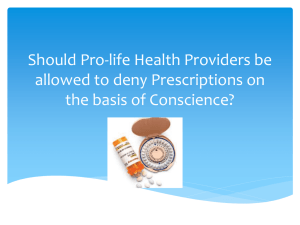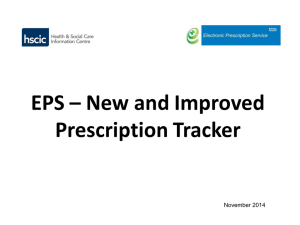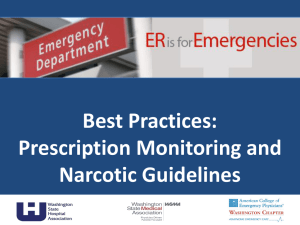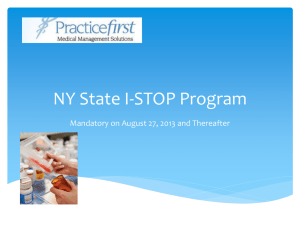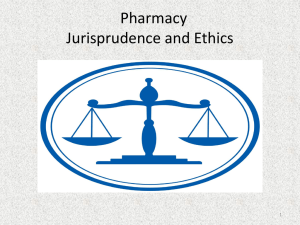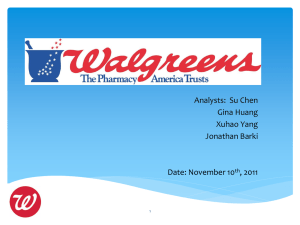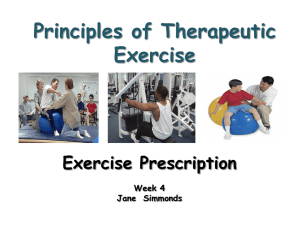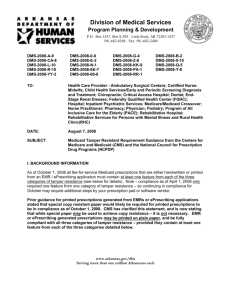I-STOP - New York State Academy of Family Physicians
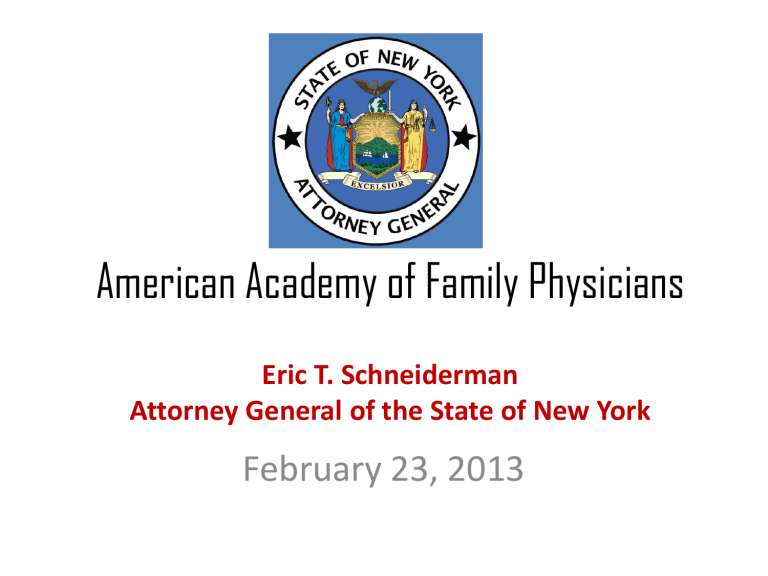
American Academy of Family Physicians
Eric T. Schneiderman
Attorney General of the State of New York
February 23, 2013
I-STOP:
Internet System for Tracking
Over-Prescribing Act
Paul J. Mahoney
Assistant Deputy Attorney General
Medicaid Fraud Control Unit
Medicaid Fraud Control Unit – MFCU
Created in 1975 as a result of abuses in the nursing home industry.
In 1977 became model for federal legislation creating the state MFCUs.
Team concept for fighting fraud:
Attorneys
Paul J. Mahoney
Assistant Deputy Attorney General
Josh Meltzer
Deputy Chief of Staff
The Epidemic in New York
Roots of the problem are two-fold:
• First, lack of education and communication between practitioners significantly increases the likelihood of over-prescribing and dangerous drug interaction
The Epidemic in New York
• Second, access to an ever-increasing supply of prescription narcotics, through legal or illegal means, has grown four-fold in the past decade
The War on Prescription Drugs :
A Statewide Epidemic
STATEWIDE Prescriptions for hydrocodone have increased 16.7%, while those for oxycodone have increased 82%
NEW YORK CITY Rate of prescription pain medication misuse among those age 12 and older increased 40% (2002 - 2009)
NASSAU
COUNTY
Medicaid prescriptions for OxyContin decreased 43%, while
Medicaid prescriptions for Opana ER increased 45% during the same time period
BUFFALO New York’s largest methadone clinic outside of New York City,
Catholic Health System, is beginning to reorganize its service to accommodate an increase in care needed to treat addicted, expecting mothers and their newborns
NORTH
COUNTRY
Health care facilities have experienced a staggering increase in percentage of non-crisis admissions for substance abuse involving prescription narcotics, eclipsing cocaine and heroin in Clinton and
Franklin Counties, and surpassing marijuana in St. Lawrence County
New York: Recent Cases
• Amagansett, NY: o Chait = Amagansett, Long Island doctor o Wrote hundreds of illegal prescriptions for patients from New York City o Chait’s “patients” drove from Bronx and Manhattan to his practice on eastern Long Island, where they paid for controlled substance prescriptions. Scripts were filled at pharmacies at exits on Long Island Expressway o Chait went from prescribing controlled substances 18 times in 10 years to issuing over 380 scripts in three months, for drugs that cost Medicaid and other insurers over $940,000 o Chait was convicted and sentenced to three years in prison followed by five years of postrelease supervision
• Medford, NY: o Laffer and Brady = prescription drug addicts o Prescribed total of 11,881 pills (June 2007 – June 2011) o Visited medical professionals eleven times over four year period o Pled guilty to a deadly robbery at Haven Drugs in Medford
• Seaford, NY: o Capano = victim, pharmacy customer, and off-duty agent for Federal Bureau of Alcohol,
Tobacco, Firearms and Explosives o McGoey shot and killed Capano during a robbery for prescription pain killers o McGoey was convicted of four robberies in Long Island
New York’s Current
Prescription Monitoring Program (PMP)
Prescription drug monitoring programs currently operate in 43 states
Practitioners transmit certain patient, practitioner, and drug information for every controlled substance prescription
(PMP collects data on Schedules II-V controlled substances)
↓
Transmissions → Bureau of Narcotics Enforcement (BNE) as late as every 15 th month day of
↓
BNE oversees PMP and collects and analyzes data to identify abuse and diversion
Pharmacists are REQUIRED to report any suspected drug diversion to BNE
Limitations of
New York’s Current PMP
• System is based on older presumptions: o How and when data is collected o Who has access to data o How data is used
• Practitioners are NOT required to provide any data to PMP
• Most practitioners do NOT access patients’ controlled substance history
• NO mechanism for pharmacists to ensure prescription presented is valid
• PMP not designed to address stolen or forged prescription pads
Limitations of
New York’s Current PMP
• Limited data access: o ONLY practitioners are permitted access o No singular patient identifier o No access protocol - patient’s data is only available to inquiring practitioner, If patient meets certain criteria, which flags patient as possible abuser/diverter: o Filling of two or more prescriptions for controlled substances from two or more physicians at two or more pharmacies o If a patient does NOT fit this profile, practitioner will get NO information
The Medicaid Fraud Control Unit
Approach:
Prescription Drug Abuse and Diversion
FINANCIAL FRAUD
Prosecution for fraudulent prescriptions average
$1 Million loss to New York taxpayers per case
Data from MFCU
New York State Medicaid spent over
$1 billion on controlled substance prescriptions 2007 - 2010
Figure 5
New York Medicaid Payments for
Controlled Substances 2007-2010
600,000,000
500,000,000
400,000,000
300,000,000
200,000,000
100,000,000
0
Total Paid
2007
Total Paid
2008
Total Paid
2009
Total Paid
2010
Total Paid
From 2007 -
2010
Class II
Class III
Class IV
Class V
Figure 6
New York Medicaid Prescriptions for
Controlled Substances 2007-2010
8,000,000
7,000,000
6,000,000
5,000,000
4,000,000
3,000,000
2,000,000
1,000,000
0
Total Scripts
2007
Total Scripts
2008
Total Scripts
2009
Total Scripts
2010
Scripts from
2007-2010
Class II
Class III
Class IV
Class V
The increase in Medicaid payments is due to the increase in prescriptions written for controlled substances during this period
MFCU’s Prescription Drug Cases
• Doctor Shopping
• Drug Diversion (Pill Mills and Drug Trafficking)
• Doc-in-a-Box
• Stolen Prescription Pads
I-STOP:
Internet System for Tracking Over-Prescribing Act
NYS Department of Health (DOH) will establish and maintain an online, realtime controlled substance reporting system to track prescribing and dispensing of controlled substances
Practitioners (agents) and pharmacists (agents) required to review patient’s controlled substance history and report information on database when Schedule II through Schedule IV controlled substances are prescribed and dispensed.
(Schedule V likely to be subject to Panel Recommendations.)↓
Practitioners will review patient's controlled substance prescription history on system prior to prescribing
↓
Practitioners will report prescription for all controlled substances at time of issuance, via E-Prescribing
↓
Pharmacists will review system to confirm person presenting such prescription possesses legitimate prescription prior to dispensing such substance, via E-Prescribing
↓
Pharmacists will report dispensation of such prescriptions to system upon dispensation
I-STOP: How It Works
• No fee/tax imposed on practitioners and pharmacists for using system
• Alternate electronic means will be in place for those without access to internet
New York’s Current PMP v. I-STOP
Practitioner
Reviewing
Practitioner
Reporting
Pharmacist
Reviewing
Pharmacist Reporting
Current
PMP
Optional; access to information restricted
None None
Mandatory reporting of controlled substances at least once every 45 days
I-STOP
Mandated review of patient history prior to prescribing
Report issuing prescription at time of issuance, via
E-Prescribing
Access to system is provided in
“real time”
Mandatory reporting of controlled substances as they are dispensed, in “real time”
I-STOP Will Enhance The Effectiveness of
New York’s Current PMP System
• Increasing detection of:
• Patient addiction
• Drug diversion
• Doctor shopping
• Identification of pill mills
• Invalidating stolen prescription pads
• Providing practitioners and pharmacists with centralized information to avoid over-prescribing
• Substantially impairs prescription drug traffickers
• Bona fide practitioners will more effectively identify patients who are at risk
of prescription drug abuse, allowing practitioners to intervene on patient’s behalf and assist patients in obtaining counseling and treatment
I-STOP & Institutional Dispensers
Institutional Dispensers (i.e., Hospitals & Nursing Homes) licensed by DOH may cause controlled substances to be administered or dispensed, pursuant to regulation.
-N.Y. Public Health Law § 3342
• Institutional Dispensers are EXEMPT from the Duty to Consult the Database in the
Following Circumstances: o Practitioner prescribing or ordering a controlled substance for use ON THE
PREMISES of an institutional dispenser o Practitioner prescribing IN THE EMERGENCY ROOM of a general hospital, provided the quantity prescribed does not exceed a 5 DAY SUPPLY o Practitioner prescribing for a patient UNDER HOSPICE CARE
I-STOP :
Necessary and Effective
Supporters:
• Federal Governmental Accountability Office (GAO), Centers for Disease Control and Prevention (CDC), insurance industry, The White House, and independent researchers suggest expansion of PMPs as a key part of solution to prescription drug fraud, abuse, and diversion
Most importantly…
• Enable practitioners and pharmacists to provide prescription pain medications, and other controlled substances, to patients who truly need them
• Will provide practitioners and pharmacists with necessary data: o Detect potentially dangerous drug interactions o Identify patterns of abuse by patients o Help those who suffer from crippling addictions o Prevent potential addiction before it starts
I-STOP Effective Dates
(from August 27, 2012)
• ISTOP C/S Registry – Mandatory utilization takes effect in one year; DOH may promulgate regulations to be immediately effective on that date
• Electronic Prescribing – Mandatory utilization for all prescriptions takes effect in two years; DOH to have regulations as to C/S E-scripting by 12/31/12
• Adjustments to Schedules of Controlled Substances o Immediately for most of the technical corrections to prior versions of
Controlled Substance sections of Public Health Law o 90 days for most adjustments to the Schedules and to definitions of certain drugs o 180 days for most changes related to hydrocodone and tramadol
• Awareness Program – immediately effective
• Safe Disposal Program – immediately effective
I-STOP:
Internet System for Tracking
Over-Prescribing Act
Paul J. Mahoney
Assistant Deputy Attorney General
Medicaid Fraud Control Unit
120 Broadway, 13 th Floor
New York, NY 10271
Paul.mahoney@ag.ny.gov
212-417-5254
NEW YORK STATE
MEDICAID FRAUD CONTROL UNIT
Eric T. Schneiderman
Attorney General of the State of New York
February 23, 2013
